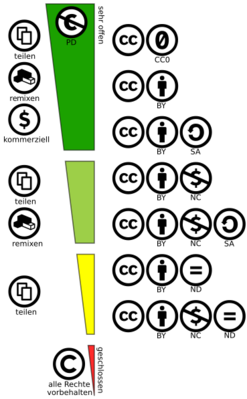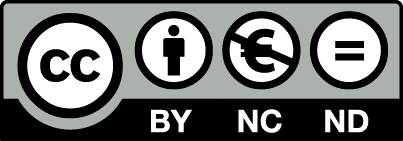Use of digital materials / copyright[Bearbeiten | Quelltext bearbeiten]
The following basic rules must be observed when creating digital media:
Third-party materials[Bearbeiten | Quelltext bearbeiten]
If you incorporate third-party materials into your teaching program, you need copyright permission. This can be granted by the author, purchased from publishers or assigned via licenses. There are also restrictions for teaching (Section 60a of the Copyright Act "Teaching and Teaching"), through which parts of works can be made available to a limited group of participants in courses. In particular, pay attention to the permissible scope in each case, e.g. a maximum of 15% of books may be used.
- The following graphic provides an overview:
- Further information from the university library on the provision of third-party materials in learning platforms:
- An explanatory video on the ELAN e.V. website explains how copyrighted materials can be made available in teaching in a legally compliant manner:
There is general permission for use in teaching for OER materials (Open Educational Resources). These free educational materials are provided under a license that allows free use in university teaching. You can also check whether you can publish your materials in such a way that they can be used freely in teaching. This creates an increasingly large pool of OER materials.
A video on the following page provides an introduction to the topic of OER:
https://open-educational-resources.de/dossierseite/?praxis=allgemein&bereich=hochschule
Providing your own material[Bearbeiten | Quelltext bearbeiten]
Even materials created by yourself and made available to students as part of teaching are subject to copyright. Students may use these materials as part of their studies and, if necessary, for other purposes specified by you. Passing them on to third parties without your permission is not permitted by law.
If you want to define such additional purposes, the license model of the Creative Commons Initiative, which has set a global standard as follows, is suitable for this.
You can use it to specify further use for your materials with some predefined rights:
| by | Use by other people is permitted, but requires the author to be named. | |
| nc | Use is only permitted for non-commercial purposes. (Non-Commercial) | |
| nd | The materials may only be used unchanged, i.e. without further processing (No Derivatives) | |
| sa | The materials may be changed, but they must be passed on under the same conditions (Share Alike) | |
| cc0 | The materials may be used freely without further conditions (Public Domain) |
The individual permissions can be combined as follows, from free use (very open) to a restricted right of use that requires individual permission (all rights reserved / closed):
 |
Source for the left graphic:
Wikipedia: Creative Commons License Spectrum. https://de.wikipedia.org/wiki/Datei:Creative_Commons_Lizenzspektrum_DE.svg creativecommons.org/licenses/by/4.0 |
When using (except for CC0), the following source information is required: Author: Title. Source, any modifications, license, license link (see example for the upper graphic on the right)
Examples of using CC licenses[Bearbeiten | Quelltext bearbeiten]
| Anyone can use a scientific text that you publish under the CC BY (attribution) license, but you must mention your name. | |
| You could publish the description of a didactic scenario that is not to be changed or taken out of context and is not to be used by companies under the CC BY NC ND (attribution, non-commercial, no changes) license. Please note that copyright only protects the specific text, not the idea described in it. No one may print or put your text of a didactic scenario on the Internet under the CC BY NC ND license, but they may carry out such a scenario. |
More information about Creative Commons licenses[Bearbeiten | Quelltext bearbeiten]
Use of materials[Bearbeiten | Quelltext bearbeiten]
The use of materials is subject to copyright, i.e. any use of texts, graphics, images, audio and video recordings, ... requires copyright permission. Materials are initially only released for personal use in studies and teaching. Copying, passing on, publishing on websites, commercial use, ... are generally prohibited.
Further use is only permitted if the author (e.g. the lecturer) permits further use, e.g. by explicitly marking materials as "public domain", a license model e.g. B. are subject to the Creative Commons Initiative, or if the use is explicitly permitted by copyright limitations: This applies, for example, to the above-mentioned exceptions for "teaching and teaching" (Section 60 Paragraph 1 of the Copyright Act) or "reproductions for private use" (Section 53 Paragraph 1 of the Copyright Act).
Further information on copyright[Bearbeiten | Quelltext bearbeiten]
Kreutzer, T., Hirche, T.: Guide to legal issues relating to digitalization in teaching
University of Bremen: Copyright for universities
Recording video conferences[Bearbeiten | Quelltext bearbeiten]
The depiction of people infringes on their personal rights (“right to one’s own image”). Video recordings, i.e. also recordings of video conferences, therefore require the explicit consent/approval of all recorded participants.
You should therefore only make recordings for your own lectures (if the video cameras of all participants are deactivated) or for small seminars if this is necessary and you have the consent of all participants.
You can find help on personal rights regarding your own image here as a PDF ("Frequently asked legal questions")
Policy / usage instructions for temporarily set up services[Bearbeiten | Quelltext bearbeiten]
The University of Paderborn has set up some new services to deal with the Corona crisis and acquired temporary licenses for external services. Please note the following:
- Most of the additional services are offered in trial operation. They do not offer guaranteed stability and availability and only limited support options. Find out about the services you use and also check whether they have a data backup, for example, or whether you should also store your data.
- Look at the respective usage and data protection information, especially for which data the respective service may be used.
- External services for which the university has not concluded contractual agreements may only be used to a limited extent. Please note the Data protection information on cloud services from American providers.
Data protection[Bearbeiten | Quelltext bearbeiten]
The university's central services are each provided with a data protection declaration. Please note that this only applies to the purposes described therein and that as soon as you download personal data from the systems, you must also ensure compliance with data protection yourself. Personal data may only be processed for the purposes required in each case and must be protected against unauthorized access. Therefore, external services always require separate agreements and measures to comply with data protection and IT security and should only be used where this is recommended by the university or after advice has been given by the data protection coordinators or data protection officers and the use of data protection-compliant use is ensured.
- Information on data protection and necessary measures can be found at:
Disclaimer[Bearbeiten | Quelltext bearbeiten]
This information does not claim to be complete. In order to protect yourself in specific cases, legal advice may be necessary, which the ZIM cannot and may not provide. The ZIM assumes no liability for the topicality, correctness and completeness of the information provided.

